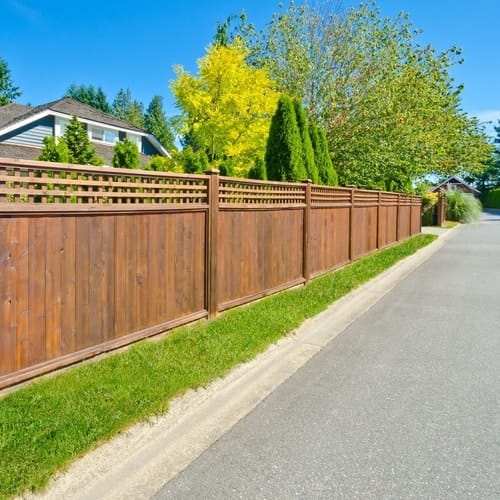Necessary Tips for Deck Discoloration Success
Achieving a flawlessly stained deck calls for greater than simply a brush and a can of tarnish. The trick to a successful deck discoloration project hinges on the thorough attention to information and adherence to necessary steps. From selecting the right kind of tarnish to mastering the art of application, each phase plays an essential role in the last end result. Whether you are an experienced DIY enthusiast or starting your initial deck discoloration experience, comprehending the nuances of the process can make all the distinction in the long life and aesthetic appeal of your outdoor room.
Selecting the Right Discoloration
Selecting the ideal stain is extremely important in achieving a long lasting and aesthetically pleasing finish for your deck. fence staining companies franklin. When picking a tarnish for your deck, it is important to think about variables such as the wood type, preferred shade, degree of security needed, and maintenance preferences
Firstly, consider the kind of timber your deck is constructed from, as various timber species might respond differently to particular kinds of stains. Woods like oak or mahogany may call for different stains contrasted to softwoods like pine or cedar. Understanding the characteristics of the wood will certainly aid you pick a tarnish that penetrates properly and improves its all-natural charm.
Next, assume regarding the shade you want for your deck. Discolorations can be found in a variety of shades, from all-natural tones that boost the wood's grain to more nontransparent colors that offer much better UV protection. Select a shade that matches your exterior area and matches your visual choices.
Moreover, examine the degree of protection the tarnish deals. Some stains supply extra substantial protection against UV rays, dampness, and mold, which can prolong the life of your deck. Balancing security with aesthetic appeals is crucial to achieving a long-lasting and aesthetically appealing coating.
Preparing the Deck Surface Area
To ensure a successful application of the chosen stain, complete prep work of the deck surface area is necessary. Make use of a deck cleaner or timber brightener along with a stiff-bristled brush to scrub the surface area tidy.
Inspect the deck for any damaged or rotten boards. Replace or repair these as needed to ensure the structural stability of the deck. Sanding the surface might be necessary to ravel harsh areas and remove any loosened timber fibers. deck staining franklin. This step not just assists the stain stick much better however also boosts the general appearance of the deck.
Using the Stain Effectively

Begin by completely mixing the discolor to ensure an even consistency. Utilize a paint stirrer to blend the discolor well, specifically if it has been sitting for a while. When using the tarnish, use a sprayer, paintbrush, or roller , relying on the kind of stain and the size of the deck. Operate in workable areas to avoid the discolor from drying out unevenly. Apply the discolor in the direction of the timber grain to make certain also coverage and a professional finish.
If a second layer is needed,Enable the very first coat to dry completely prior to determining. Comply with the maker's guidelines pertaining to drying out times and reapplication. Correct application of the discolor is crucial for safeguarding your deck and enhancing its look for years why not try this out to come.
Keeping Your Tainted Deck
After successfully applying the stain to your deck, preserving its look and safety top qualities is important for lasting resilience and visual charm. Normal upkeep is key to protecting the elegance and integrity of your stained deck. Dealing with look at more info concerns promptly can avoid them from getting worse and extend the life of your discolored deck.

Troubleshooting Common Issues
Recognizing and dealing with usual problems that might arise with your discolored deck is essential for ensuring its long life and optimal performance. One usual problem is flaking or peeling off of the stain.
An additional issue usually experienced is mold and mildew and mildew growth on the deck surface area. This can be attributed to moisture retention, absence of sunshine, or improper ventilation. To tackle this trouble, an extensive cleaning with a mold and mildew and mildew cleaner complied with by correct drying and application of a mold-resistant discolor is critical.
Furthermore, fading of the discolor shade over time is a common problem. UV direct exposure and rough weather can cause discoloration. To resolve this, picking a top notch, UV-resistant tarnish and applying a fresh layer periodically can assist keep the deck's aesthetic allure.

Verdict
Finally, successful deck staining calls for picking the appropriate tarnish, effectively preparing the deck surface area, using the discolor correctly, and keeping the discolored deck. By complying with these vital tips, you can attain a beautifully discolored deck that enhances the total appearance of your like this exterior area. Keep in mind to fix any usual problems that might occur throughout the staining procedure to guarantee a durable and visually enticing outcome.
Achieving a faultlessly stained deck needs even more than just a brush and a container of tarnish.To guarantee an effective application of the chosen discolor, thorough preparation of the deck surface area is important. When applying the discolor, make use of a sprayer, roller, or paintbrush, depending on the type of discolor and the dimension of the deck.Identifying and attending to usual concerns that may occur with your tarnished deck is important for guaranteeing its long life and ideal efficiency.In conclusion, successful deck discoloration calls for choosing the best tarnish, properly preparing the deck surface, applying the tarnish appropriately, and maintaining the discolored deck.